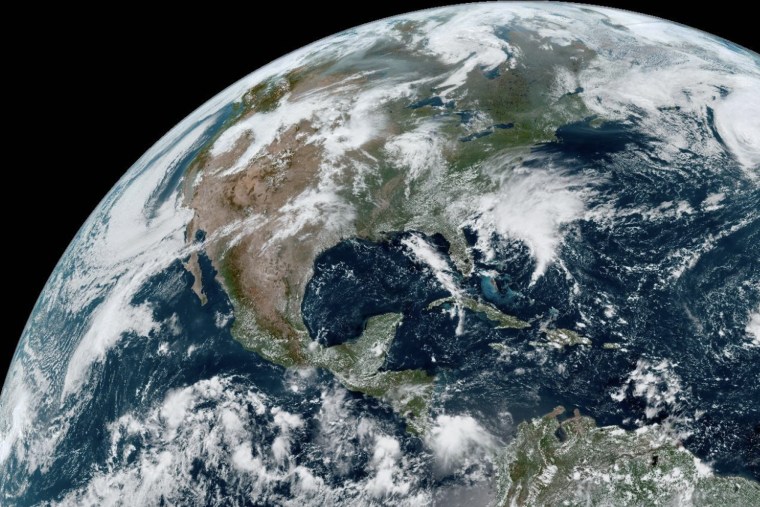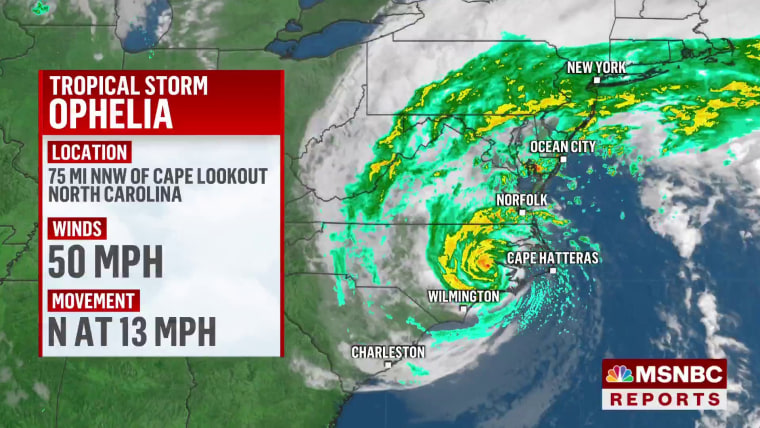Tropical Storm Ophelia made landfall in North Carolina early Saturday, bringing rain and high winds that have already been striking the region, and the threat of potentially life-threatening flooding, forecasters said.
Ophelia hit the coast “near Emerald Isle in North Carolina with maximum sustained winds of 70 mph,” shortly after 6:20 a.m., the National Hurricane Center said on X, formerly known as Twitter.
What had been “potential tropical cyclone sixteen” strengthened to Tropical Storm Ophelia around 2 p.m. Friday in the Atlantic Ocean.
The effects of the storm were already being felt in North Carolina and Virginia on Friday as the storm approached, with rising coastal waters, high winds and rain, officials said.
By early Saturday, more than 41,000 customers were without power in North Carolina and just over 19,000 in Virginia, according to poweroutage.us.
"Potentially damaging winds, dangerous storm surge, and life-threatening flash flooding" were expected in eastern North Carolina and southeastern Virginia, the agency said in a bulletin.

A hurricane watch covered the eastern North Carolina coast from north of Surf City to Ocracoke Inlet. Other areas had tropical storm and storm surge warnings.
Govs. Roy Cooper of North Carolina, Gov. Glenn Youngkin of Virginia, and Wes Moore of Maryland declared states of emergency in advance of the storm. Emergency declarations allow for state aid and other assistance.
The National Weather Service in Wakefield, Virginia, said there were wind gusts of up to 50 mph as the storm approached. Fayetteville, North Carolina, had winds of 37 mph. Rain was also falling in the region.
The Coastal Plain region of North Carolina could get 3 to 5 inches of rain, and "The Triangle," which includes Chapel Hill, could see 2 inches, according to the agency.
New York City issued a travel advisory for the weekend due to Ophelia and a warm front. There could be between 2 to 3 inches of rain this weekend, the National Weather Service in New York said. Low-lying areas and areas with poor drainage could flood, the city's Emergency Management Department said.
In addition to the winds, there could be storm surge of up to 4 to 6 feet in some areas, including the Pamlico Sound, according to the hurricane center. An area from Surf City to Chincoteague, Virginia, could see a storm surge of 2 to 4 feet, it said.
Tropical storm warnings reached into Delaware and Chesapeake Bay. The storm is forecast as a tropical storm in North Carolina and Virginia, but then to weaken to a tropical depression.
There could be isolated rainfall totals of 7 inches in eastern North Carolina and southeastern Virginia, but rainfall amounts there were generally expected to be 3 to 5 inches. Other Mid-Atlantic states could see 2 to 4 inches of rain, according to the hurricane center.
It is not uncommon for one or two tropical storms, or even hurricanes, to develop right off the East Coast each year, National Hurricane Center Director Michael Brennan told the Associated Press.
“We’re right at the peak of hurricane season, we can basically have storms form anywhere across much of the Atlantic basin,” Brennan added.

